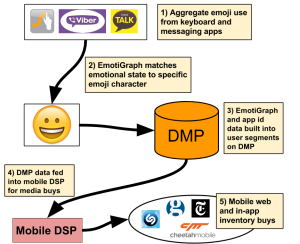That Emoji Ad Network: The Global Scale of Emotional Targeting
by Lindsay Rowntree on 26th Feb 2016 in News

On Monday (19 February), Ciaran O’Kane, CEO, ExchangeWire published a piece as a precursor to the biggest mobile event of the year, Mobile World Congress. As well as touching upon the device graph and the rise of programmatic native, O’Kane shared with the world a solution to monetising the plethora of emojis that exist globally.
Not ones for duplicating content, but such was its popularity, ExchangeWire are delving into this idea in more detail, just in case somebody out there has grand plans to turn the Emoji Ad Net into a reality.
As O’Kane referenced in the previous piece, the APAC region has a good handle on emoji monetisation, and Line is a great example of this. It has created a ‘glocal’ app monetisation mechanism in localising emojis for a global audience. It has done this through creating sponsored emoji stickers by collaborating with local brands and promoting emoji sticker packs, which their users can purchase. Line even formed a partnership with BuzzFeed, with a promotion of animated BuzzFeed stickers if you accessed it through the Line app. They went even further by making their emoji keyboard available as a separate entity through iOS to ensure it still has traction in markets dominated by other messaging apps.
However, while interest is strong from brands to have their own emojis (Line’s Burberry collaboration and Twitter’s #redcups partnership with Starbucks as examples), the process is a difficult and incredibly fragmented way to, basically, be able to include brand logos in messages, just because you can. As O’Kane pointed out, such soft brand metrics might be very effective in the likes of Japan; but global scalability requires effective measurability.
The idea is to be able to aggregate emoji use across multiple messaging apps, across the world (WhatsApp, Line, WeChat, Telegram, Viber, etc); and measure emoji performance, as you would any other performance channel, to understand whether it’s adding any value to your campaigns.
What if you could not just measure the effectiveness of your own branded emojis, but also tap into a wealth of emoji usage data and build that into your media buys? It potentially paints mobile as a very different landscape.
O’Kane compiled a basic, direct-response model to demonstrate emoji use on messaging and keyboard apps and the interesting angles that exist in mobile. Ad tech is the catalyst for opening up new monetisation opportunities within the mobile space, and emojis seem like a relatively untapped opportunity on a global scale.
Emotional Retargeting: The Emoji Ad Net Breakdown

The monetisation steps explained
- Aggregate emoji use from keyboard and messaging apps
iOS and Android both have open APIs, resulting in hundreds of keyboard apps and second-tier messaging apps. There is an opportunity to aggregate global emoji use at scale across these platforms.
- EmotiGraph matches emotional state to specific emoji character
This step requires the help of linguistic specialists to help build the EmotiGraph – a probabilistic model that links emoji use to specific real-time emotional states. There will surely be a margin of error. But if someone has indicated via an emoji that they are hungover, it’s likely brands such as Berocca, KFC, et al would buy media using that specific segment.
- EmotiGraph and anonymised app ID data built into user segments on DMPs for media buys
The real value proposition here will be the segments built by the DMP, combining EmotiGraph data and anonymised app IDs. These segments will be used for programmatic media buys.
- DMP data fed into mobile DSP for media buys
There is no need to build bidder tech or execution infrastructure, given so much of this has already been built. The real value is the segments built for programmatic buys.
- Inventory bought across mobile web and app inventory in real time
By leveraging scaled emoji use, advertisers can target a specific emotion data point in real time. Buying in-app or mobile web inventory via a mobile DSP allows brands to customise messaging to users on a mobile device.
Not to condone the consumption of alcohol with another alcohol-related example, but, if someone has indicated they’re out drinking via an emoji, and that is overlaid with granular location data, bar and pub chains would be able to target them. Overlaying that data further with time-of-day could determine how that person’s night is progressing and whether they should be targeted with a Dominos or even an Uber ad.
Bringing it back around to branded emojis, an emoji ad network gives brands enormous power to own and expand their brand real estate. Zynga could overlay EmotiGraph data with first-party data to determine Zynga app ownership and usage against use of King’s Candy Crush Saga emojis and target accordingly to an, arguably, much more captive audience.
There's a beauty of the immediacy of the emoji and the emotional state it conveys of someone at that point in time. The ability to target someone in real time based on instant emoji usage, versus building a deeper profile of users based on their emoji usage over time, could provide advertisers with a deep understanding of their target audience in a way that existing data from anonymised app IDs cannot.
If you want to give yourself a headache, emojitracker shows real-time emoji usage on Twitter and it’s terrifying. But it really does show how emojis are part of our everyday language and, more than that, a global language. Given that the Oxford Dictionaries’ Word of the Year 2015 was the ‘Face with Tears of Joy’ emoji, now seems like a great time to monetise this global language.
Ad NetworkDataDMPMobileTargeting








Follow ExchangeWire